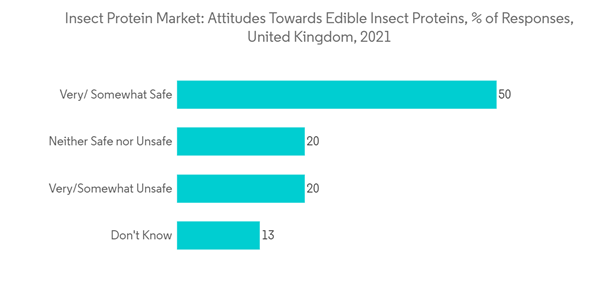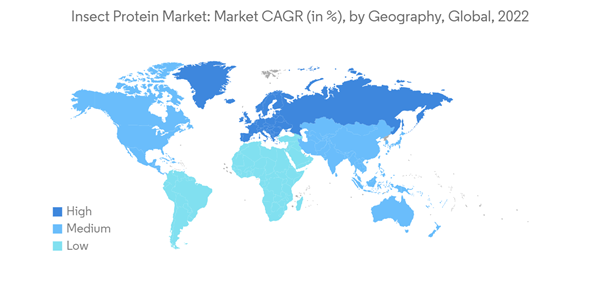The insect protein market size is expected to grow from USD 299.6 million in 2024 to USD 362.54 million by 2029, at a CAGR of 3.89% during the forecast period (2024-2029).
This product will be delivered within 2 business days.
Key Highlights
- The insect protein has been gaining traction in various parts of the globe due to various factors. European Union officers have suggested that mealworms can be used as a source of protein to fortify cookies, pasta, or baked goods. According to the National Library of Medicine, insect pprotein can contain a substantial amount of protein. As per an article published by the National Library of Medicine, freeze-dried yellow mealworm larvae contained up to 33% fat, 51% crude protein, and 43% true protein on a dry matter basis.
- Additionally, insect protein is more eco-friendly as compared to raising cattle and other bigger sources of protein. Hence, many regions across the globe have been considering insects as potential sources of protein. Many regions have been witnessing the expansion of insect farms to cater to the growing demand for insect protein for animal feed, food & beverages, supplements, etc. For instance, in May 2022, Russia's first cricket farm was opened in Novosibirsk Oblast. The farm was intended to introduce a new protein source to the feed components market in Russia.
- Insect protein is also being widely used in pet food to increase its nutritional value. Various companies have been increasing their insect protein offerings and expanding to new regions. For instance, in November 2021, Ÿnsect launched its first product in the United States in collaboration with Pure Simple True LLC. The company launched a high-value protein that was used as a core ingredient for the dog treat brand Bernie's in the United States market. Hence, the increasing demand for insect protein ingredients by various end-user industries, coupled with an increased market penetration of insect protein offerings in the market, is anticipated to drive the market studied over the forecast period.
Insect Protein Market Trends
Increasing Awareness About Insect & Other Alternative Proteins
- Insect protein has been gaining traction in the market as consumers have become more aware of various sources of protein and their benefits on health. Insect protein intake among consumers is increasing, with more attention being paid to the specific demand for protein for various health benefits. With increasing population and welfare, the demand for insect protein as a food-nutritional component has been rising over the past few years. The high protein trend is gaining traction and will continue to evoke interest in the upcoming years.
- Hence, many companies have been expanding the production of insect proteins and expanding their presence across various regions. For example, in March 2022, Singapore-based start-up Inseact opened an insect protein facility with advanced technologies to expand its production. Additionally, the company will be the first commercial-scale insect protein manufacturer in Malaysia in 2022.
- Various regions across the globe have been witnessing a rise in awareness about insect protein and the benefits of consuming it. According to a survey published by the Food Standards Agency in 2021 in the United Kingdom, 50% of the respondents believed that edible insects were very/somewhat safe, whereas only 13% of the respondents had no awareness of edible insects.
- The advantages of insect protein include more or comparable quantities of protein as well. It is claimed to have better digestibility than other animal and plant proteins, which has been constantly driving its demand in the food and beverage sector. Manufacturers have been offering various insect protein products to cater to the growing demand for the same in the global insect protein market.
Europe as the Dominant Region with Major Market Shares
- Europe is the dominant market for insect protein across the globe. The region has been considering insects as a sustainable, eco-friendly, and potential source of protein. Government initiatives and approvals for various insects as sources of protein for food, beverages, animal feed, and other applications have been playing a major role in driving the insect protein market across Europe.
- The European Commission authorized the 4th insect, Alphitobius diaperionus, the lesser mealworm in the market, as food in the year 2023. The lesser mealworm is the larval form of darkling beetles. The lesser mealworm was approved as a novel food. The novel food consisted of paste, powder, frozen, and dried forms of house cricket. These were intended to be marketed as a food ingredient in several food products for the general population in Europe.
- Hence, the government approval for the usage of insect protein in various food and beverages creates many opportunities for different companies to enter the market with their insect protein offerings and innovate new formulations of insect proteins to be used in food and beverages. These factors, when clubbed all together, could lead to the expansion of the insect protein market in Europe. More options of brands and insect protein variants and forms allow the end-users to choose from a wider selection of ingredients, which could, in turn, drive the market.
- Furthermore, insect protein is a potential source of nutrients being used in animal feed. Insects can provide protein and essential amino acids for pigs and poultry that can potentially replace other protein meals for animal feed, such as soybean meal in a diet. Furthermore, insects are viewed as a sustainable source of protein for the animal feed industry. The digestible protein in insect larvae makes them a potent solution to improving protein self-sufficiency in animal feed. Hence, the increasing practice of rearing livestock owing to rising demand for meat products like fish meat, pork, beef, veal, poultry, etc., could create opportunities for insect protein to be used as animal feed across the region.
- According to the Department for Environment, Food, and Rural Affairs, the production of pigs and pigmeat in the United Kingdom increased from GBP 1,461 million (USD 2002.57 million) in the year 2021 to GBP 1,727 million (USD 2367.99 million) in the year 2022. Hence, the increasing practice of raising animals across the region can drive the insect protein market across Europe.
Insect Protein Industry Overview
The global insect protein market is fragmented, with several companies offering insect proteins in the market globally. Some of the major players operating in the market include Aspire Food Group, Darling International Inc. (EnviroFlight), Ynsect NL B.V., Protix B.V., and Protenga. The key players offering insect protein globally have been using various corporate strategies like partnerships, mergers & acquisitions, and expansions. To cater to the growth of insect protein and achieve economies of scale, the players operating in the market have been expanding their production capacities. Additionally, the companies have been incorporating advanced technologies in their production plants to streamline the production of insect proteins. The companies operating in the market have also been paying keen attention to promoting the benefits of insect protein and distribution of the same to strengthen their position in the global insect protein market.Additional Benefits:
- The market estimate (ME) sheet in Excel format
- 3 months of analyst support
This product will be delivered within 2 business days.
Table of Contents
1 INTRODUCTION
4 MARKET DYNAMICS
5 MARKET SEGMENTATION
6 COMPETITIVE LANDSCAPE
Methodology

LOADING...










